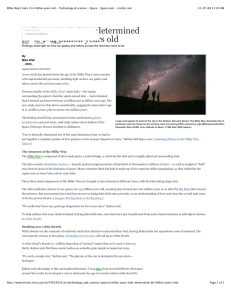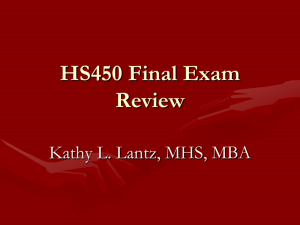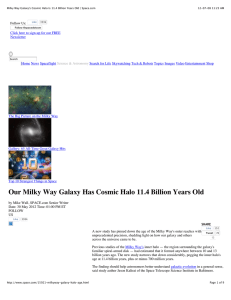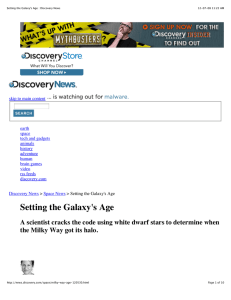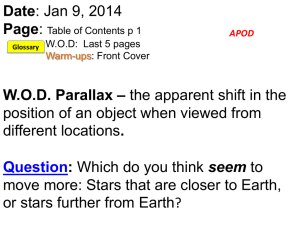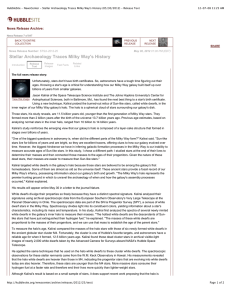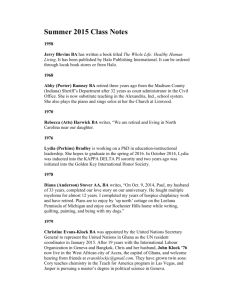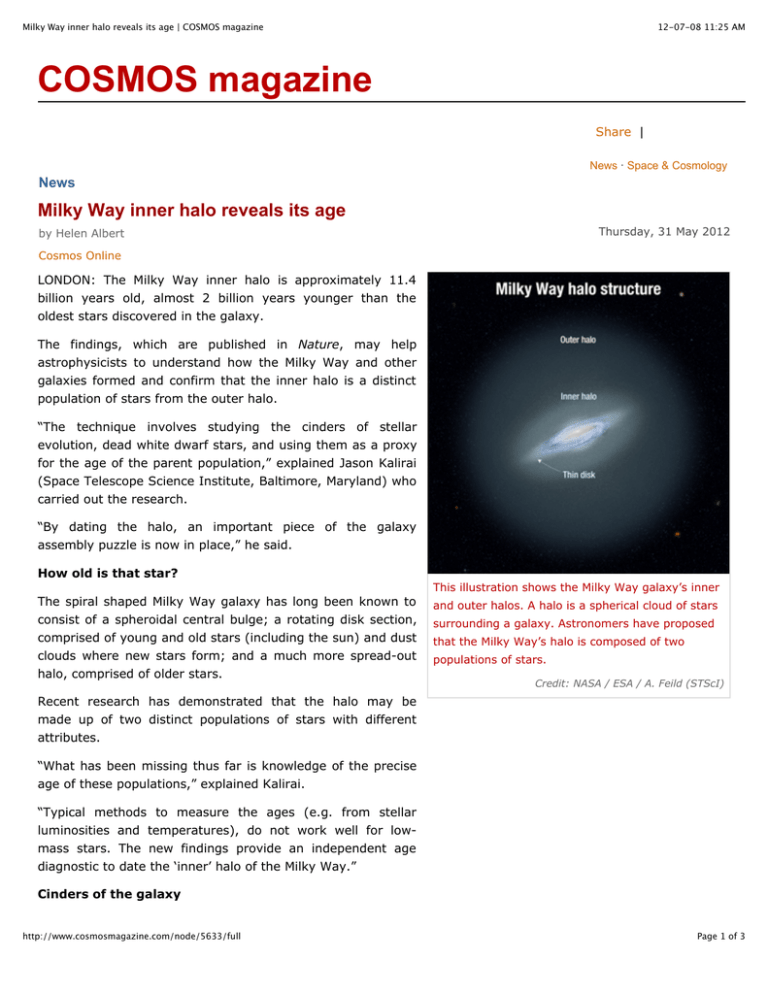
Milky Way inner halo reveals its age | COSMOS magazine
12-07-08 11:25 AM
COSMOS magazine
Share |
News ! Space & Cosmology
News
Milky Way inner halo reveals its age
Thursday, 31 May 2012
by Helen Albert
Cosmos Online
LONDON: The Milky Way inner halo is approximately 11.4
billion years old, almost 2 billion years younger than the
oldest stars discovered in the galaxy.
The findings, which are published in Nature, may help
astrophysicists to understand how the Milky Way and other
galaxies formed and confirm that the inner halo is a distinct
population of stars from the outer halo.
“The technique involves studying the cinders of stellar
evolution, dead white dwarf stars, and using them as a proxy
for the age of the parent population,” explained Jason Kalirai
(Space Telescope Science Institute, Baltimore, Maryland) who
carried out the research.
“By dating the halo, an important piece of the galaxy
assembly puzzle is now in place,” he said.
How old is that star?
The spiral shaped Milky Way galaxy has long been known to
consist of a spheroidal central bulge; a rotating disk section,
comprised of young and old stars (including the sun) and dust
clouds where new stars form; and a much more spread-out
halo, comprised of older stars.
This illustration shows the Milky Way galaxy’s inner
and outer halos. A halo is a spherical cloud of stars
surrounding a galaxy. Astronomers have proposed
that the Milky Way’s halo is composed of two
populations of stars.
Credit: NASA / ESA / A. Feild (STScI)
Recent research has demonstrated that the halo may be
made up of two distinct populations of stars with different
attributes.
“What has been missing thus far is knowledge of the precise
age of these populations,” explained Kalirai.
“Typical methods to measure the ages (e.g. from stellar
luminosities and temperatures), do not work well for lowmass stars. The new findings provide an independent age
diagnostic to date the ‘inner’ halo of the Milky Way.”
Cinders of the galaxy
http://www.cosmosmagazine.com/node/5633/full
Page 1 of 3
Milky Way inner halo reveals its age | COSMOS magazine
12-07-08 11:25 AM
Kalirai used a technique he had previously developed which
calculates the time for a star to evolve from its initial fuelburning state to its current white dwarf state by comparing
their masses. Stellar mass governs how long a star is able to
burn hydrogen for.
Using this method, he estimated that the stars in the inner
halo of the Milky Way are 11.4 billion years old, which is
within the range of previous estimates of 10 to 14 billion
years. The oldest reliably aged cluster of stars in the outer
halo region to date is 13.5 billion years old.
White dwarf stars form when normal stars like the sun have
burnt up all their fuel and lost their outer layers. The centre of
the star becomes white hot before cooling over many years.
“White dwarfs are remarkable objects,” said Kalirai. “They contain approximately the mass of the Sun in a
volume that is the size of the Earth. This means they are very dense. “
He explained that “the extreme conditions of a white dwarf cause their spectra to have a very strange shape, one
that can be modeled to yield the temperature and mass of the star.”
The differing distances of halo stars from the Earth make measuring age by more traditional methods such as
comparing temperature against luminosity very difficult, commented UK astrophysicist Nick Cross from the Royal
Observatory in Edinburgh.
“However, using the spectroscopic widths of the Balmer lines in the atmospheres of white dwarfs give masses
without the need for distances,” he noted. “The width depends on the gravity and the pressure, which are both
dependent on the mass.”
Kalirai compared the masses of newly formed white dwarf stars located in the inner halo of the Milky Way with
those of white dwarfs in the well-known 12.5 billion year old globular cluster known as Messier 4 located in the
outer halo. He found that the inner halo white dwarfs were heavier, indicating that their parent stars were also
heavier and therefore younger than the white dwarfs in Messier 4.
Birth of the Milky Way
Information obtained using the European Southern Observatory’s Very Large Telescope in Chile was used to
estimate the masses of the inner halo white dwarfs and from the Keck I Telescope in Hawaii to measure the
masses of the outer halo white dwarfs.
“This new discovery provides important insight on when Milky Way type galaxies built up their inner regions
within the chronology of the Universe,” said Kalirai.
Discussing the work, astrophysicist Ata Sarajedini (University of Florida, Gainesville, USA) commented: “The
initial mass-final mass relation for white dwarf stars has implications for our understanding of how normal 'main
sequence' stars like the Sun evolve to become 'dead' stellar remnants at the end of their lives as white dwarfs.”
He added that “using white dwarfs to measure the age of the inner Milky Way halo helps us to understand how
long it took the halo to form and the chronology of formation.”
Technique has promise, but more testing needed
http://www.cosmosmagazine.com/node/5633/full
Page 2 of 3
Milky Way inner halo reveals its age | COSMOS magazine
12-07-08 11:25 AM
Cross said that the finding “adds more evidence that the inner halo is a distinct stellar population from the outer
halo,” which is a fairly recent discovery.
“Understanding exactly when the stars in these structures formed, combined with detailed measurements of the
dynamics and chemical content, allows us to understand whether stars were accreted from dwarf galaxies, as
seems to be the case for a significant fraction of the outer halo, or whether they formed within the galaxy, as in
the case of the inner halo,” he added.
When asked about his future research, Kalirai said that whilst the technique has promise it needs to be tested on
more inner halo white dwarfs to confirm the accuracy of the age estimate.
“For example, if the halo formed over an appreciable age range, we should see a large dispersion in the white
dwarf masses. If the outer halo of the Milky Way is indeed as old as the oldest globular clusters, its white dwarf
population should be under massive relative to the ones we've studied so far.”
More information
The full text of the paper, "The age of the Milky Way inner halo", published in Nature
European Southern Observatory website
W. M. Keck Observatory website
Jason Kalirai homepage
Add new comment
Privacy policy | Support | Terms and Conditions | RSS feeds
©2006-10 Luna Media Pty Ltd. All rights reserved.
http://www.cosmosmagazine.com/node/5633/full
Page 3 of 3

